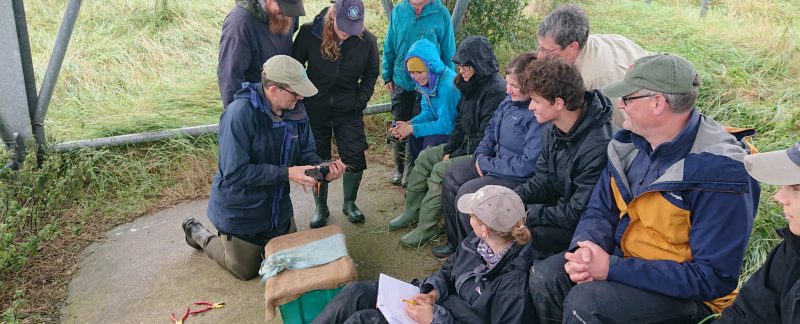Decoy making weekend 29–30 July
Before The Wash week began, a dedicated team got together at Nigel and Jacquie’s house to make up a batch of decoy birds to aid us with future catches. The end product is a life-like model which we can place in the catching area, during cannon-netting, to attract birds. Nigel was an excellent teacher and we all learnt so much, not only about how to make a decoy, but about the fascinating anatomy of the birds. Those on the weekend were Ryan, Molly, Kirsty, Nigel, Jacquie, Katharine, Flo, Lucy, James, David, Sam and Skye.
We also had good fun helping Jacquie and Nigel with their CES at Hinderclay Fen and caught the first Sedge Warbler and Kingfisher for the year!
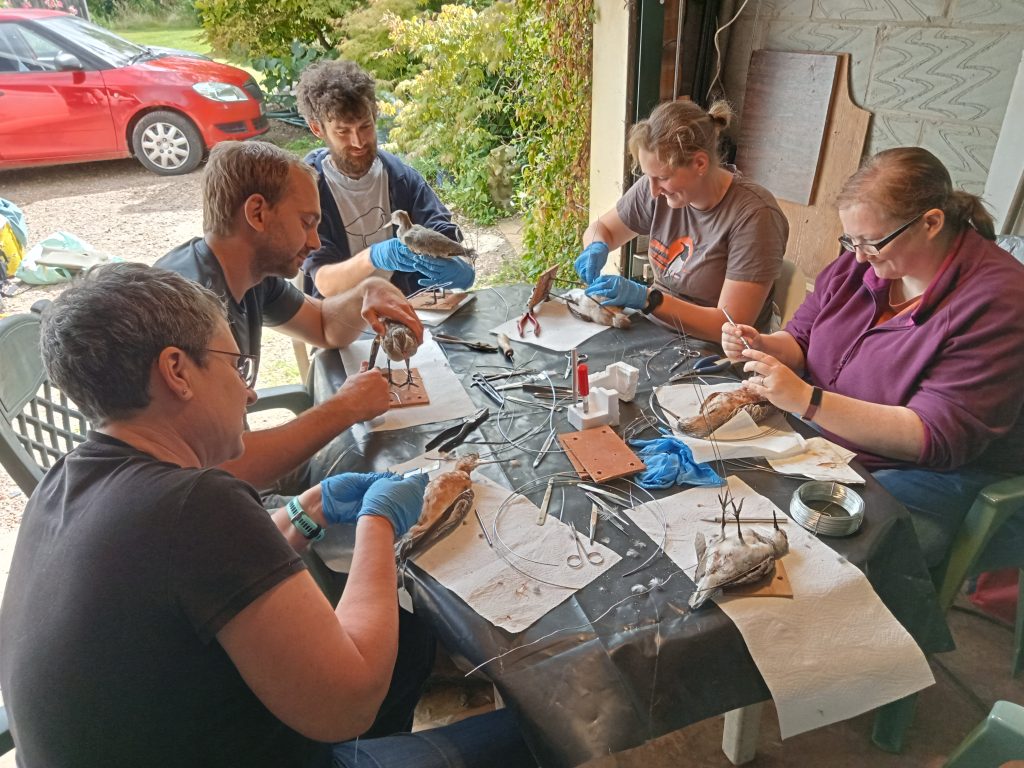
Wednesday 2 August
Before the start of the first Wash week of the year, several members had carried out recces on Tuesday evening: Richard and James saw over a few thousand Knot at the Horseshoe Lagoon in Lincolnshire; Tim and Cathy went to Gedney and saw Bar-tailed Godwit and Curlew, but they were too far out to make this site promising as a catching option; Molly saw 50 Turnstone and 100 Sanderling at Heacham North North; and Daniel found more Sanderling from Heacham South to Snettisham, as well as Oystercatchers which were observed flying off towards Ken Hill. On Wednesday morning Richard and James, and Molly and Daniel repeated the same recces. The Lagoon produced similar results of excitingly large numbers of Knot, Daniel saw 600 Sanderling (and Knot swirling in a distant smoke), and Molly found 150 Sanderling with 15 Turnstone and a few Ringed Plover and Dunlin.
Most of the team arrived at the base house around midday, in good time to admire the new porch which was near completion. It has been very well done and the style is in keeping with the rest of the building. Molly and Flo sorted out a bits and bobs lunch for the team, and then we gathered in the lounge for introductions and the first team briefing. There were lots of new faces, in addition to some very experienced ones, and the room was filled with enthusiasm. Based on Richard and James’ sighting of 3,000+ Knot at the Horseshoe Lagoon in Lincolnshire that morning, a plan was made to set a couple of nets there in the afternoon and hopefully catch them the following morning.
Cars were packed, the trailer was loaded with all the equipment needed, and Molly and Flo got together the food we’d need to sustain us until Thursday afternoon. While Ryan (to recce Heacham and Ken Hill) and the Bone family (to recce Terrington Marsh) stayed at the base, the rest of the team present drove up to Lincolnshire. Becky, Ursula and Sarah went straight to Friskney Village Hall to begin making the dinner (after a little struggle with getting the gas going on the oven, involving the caretaker and someone else he called in) and everyone else went to the Horseshoe and set two parallel nets. One, raised on a small mud wall was a three-cannon small-mesh net set further out into the lagoon, and the other, behind it, was a full-size, small-mesh net.
Richard and Kirsty returned to the base, a team stayed at the Lagoon to observe what the birds did on the evening tide, Lizzie led another group to resight Redshank at Freiston and Katharine, Tim, Molly and Flo returned to the village hall to finish making the jacket potato dinner. Bob arrived at this point as well. The team who were out watching reported that 30–40 Oystercatchers came in alongside 600–700 Knot, though some birds did head further north; however, good numbers remaining near the nets made the morning’s catching attempt look promising.
After dinner, Steve, Nigel and Lizzie led a briefing to cover the morning’s catch, teaching those new to the group about what to do when the net fires and explaining everything that follows, and we divided up into teams. Nigel explained that there would be a film crew out with us in the morning to see the catch and talk to members of the group. Two previous members from the 1970’s, Peter and Andrew, would be coming as well.
Back in Norfolk, Ryan and Christine had seen the following on their evening recce: 100 Sanderling, 30 Turnstone and a few Ringed Plover and Dunlin at Heacham North North, spread out in three groups; not much activity at Heacham North due to there being lots of people; 200 Sanderling and no Oystercatchers at Heacham South, but the birds were moving about a lot around the Ringed Plover exclosures, making them uncatchable; and nothing found at Ken Hill, but there were two tagged Curlew behind the caravan park.
A busy first day, many of us (especially those who’d spent the weekend making decoys) were already quite tired and gratefully wriggled into sleeping bags and tried our best to get a good night’s sleep before the morning arrived.
Thursday 3 August
After a decently early start, the hide team (Steve, Nigel and Richard) and the tarp team were in position at 06:00. The hide was Steve’s truck and this was positioned overlooking the Lagoon. The tarp team (consisting of Lizzie, Katharine, Kirsty, Molly, Ian, Seb, Flo and Jen, who had just arrived) were folded, taco-style, in layers of tarpaulin in the grass, hidden not far from the nets. Oystercatchers began piling in within 15 mins, and the tarp team could hear their piping and chattering as they flew over in large drifts. Most built up in front of the three-cannon net, and only around 50 or so in front of the four-cannon net. All this was communicated over radio from the ‘hide’, and it was noted that although there were Knot (as hoped), they were too far off and we’d have to wait much longer for a good enough sample to accumulate. The hide team decided not to wait and team members under tarp, and the rest of the team who had arrived by this stage, were notified that the hide team had armed the firing box and were jiggling to encourage birds to move away from the net.
The next we heard was BANG! Out we all ran, lifted the net a short way to get all the birds onto dry land, and began extracting. Time of fire was 07:10, and it was the three-cannon net that was fired. Despite the large number of birds, we had a skilled team and extraction was very quick. As a result of firing into the wind, the net billowed a bit as it came down, and a number of birds flew out before it landed. All the birds were taken to keeping cages on a strip of grass Nigel had strimmed yesterday during setting. To mitigate the risks of HPAI birds from a single keeping box or sack were put into a single compartment.
We split into three processing teams – lead-processed by Nigel, Jen and Richard (who did the retraps) – and one ringing team, led by Lizzie and Molly. Meanwhile, after talking to the film crew, Steve went to resight Redshank and to recce various fields for catching options. Nigel gave lots of training to less experienced members whilst measuring, ageing and moult-scoring the birds. We learnt more about arrested moult, a fascinating method of preserving energy by not moulting the previous year’s primaries, which we are seeing in Oystercatchers, possibly a result of lower shellfish populations last year. The most humorous moment of the day was when an Oystercatcher bit Bob just as he was about to weigh it… “Ouch! It got me on the nipple!”. As you might guess, we were all in hysterics. One Oystercatcher had peculiar plumage, with white spots all over its head and neck.
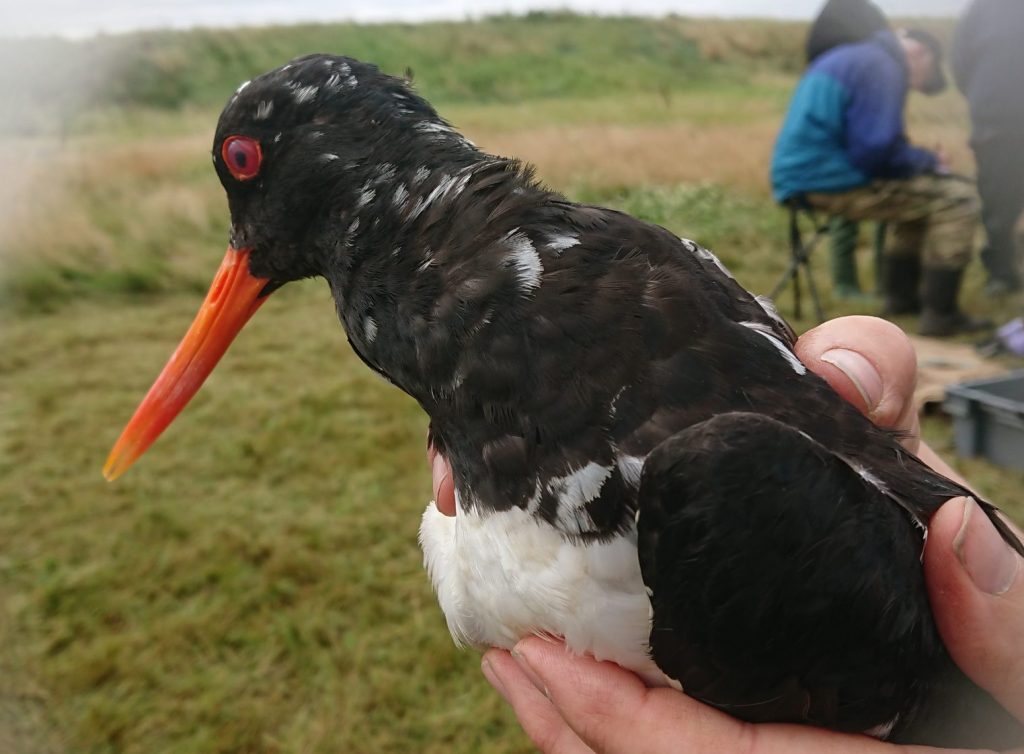
Throughout the whole catch and processing, the film crew made videos and interviewed team members. They were friendly, patient and understanding, as well as not being intrusive and at the end thanked us gratefully for allowing them to be part of the morning. The documentary they are making is about The Wash and its wildlife, and we really hope our work will help them and others to understand more about the importance of this land for the wintering waders, and the significance of our ongoing research.
Horseshoe (Lincs) 3 August 2023
| Species | New | Retrap | Total |
| Oystercatcher | 201 | 21 | 222 |
| Totals | 201 | 21 | 222 |
Everyone regrouped at the village hall for the traditional post-catch porridge and fry-up (thank you Molly, Flo and Bob!), and Steve led a briefing to follow up on the morning’s catch. There were lots of positive comments on how well the ringing and processing teams had managed the birds coming through. Steve and Lizzie together formulated our next plan of action, based on Ryan’s morning recces in Norfolk. Ryan had seen similar numbers after redoing the same beaches and this sealed Heacham as the likeliest next catch option. “So, who wants to stay the night with Steve?” was asked to the team. Tim bravely put himself forward (or was he put forward by the team?), and the two of them stayed at Friskney Village Hall that night in order to resight and recce in the afternoon and the next morning around Lincolnshire, while everyone else returned to the base in Norfolk.
Those who returned to the Norfolk base found Ryan had been diligently cleaning out cartridges throughout the morning. Kirsty and Christine got straight to work checking through the catch data, and with Ewan and Daniel, Christine also cooked up a super pasta salad for dinner. We had a team talk to discuss sites that needed to be looked at for catching options, and Richard went to check Terrington Marsh to look for catching options and see if the water had yet reached the pools (no birds were seen but water was present). Between the team meeting and dinner we had a relaxed afternoon, some sitting out in the unexpectedly clement weather and taking the dogs, Fly and Willow, for a sunny stroll. After the meal, the recces began: Ryan, Molly and Bob went to Heacham North North; Lizzie and Christine went to Heacham South; and Jen and Lys went to Snettisham Beach. Paul, Ian, Ursula, Seb and Flo went to the Snettisham Pits to do some resighting, but only gained one and a partial colour-combination reading (credit fully to Seb) due to the tide rising much earlier than expected, obscuring legs. However, they estimated there were some 20,000 Knot, 800 Black-tailed Godwits, 2,500 Dunlin and 3,300 Oystercatchers in the Pits, an incredible sight which was made all the more special by a lovely sunset over the sea. The lack of resightings became an issue as, much to their dismay, as they returned to the base late for pudding they were told by Richard that they’d receive one strawberry for every resight they got. What a pity. The plan to catch at Heacham South was finalised, and we all made our way to bed.
Friday 4 August
One team went early to set a full, small mesh net on Heacham South, followed by a basecamp team. Molly and Flo went to Heacham North North to locate the point of beach covered by the tide last, therefore identifying where the birds would congregate first as it started to recede again. This was to prepare a second catching option, should the rest of the team not catch (or catch low numbers) at Heacham South. Unfortunately, despite a bit of twinkling (gently encouraging birds into the catching area using subtle movements), there were few catchable birds on Heacham South, and no catch was made. The net was lifted and packed away, and everyone made their way to Heacham North North. Lizzie and Richard scoped the beach where Molly and Flo indicated and, after a little wait to let the tide start to fall, we swiftly reset the net in its new position.
To communicate what was going on with members of the public passing by, we had longstops in place on the sea wall (Christine and Paul at the north end, and Seb at the south end). Richard, Kirsty and Lizzie were on the beach. Richard made the final call on the catch, and, when the net fired, we lifted the net onto the sand and begin extraction. The majority of the catch was Sanderling, but we also caught Ringed Plover and Turnstone, one of which was colour-ringed! During processing, Nigel arrived and then went with Christine, Jen and Lys to join Katharine and Jacquie at Pensthorpe where they were fitting GPS/GSM tags to head-started Curlew (BTO monitoring work rather than WWRG tagging). Several passers-by stopped to ask what we were up to as we ringed and processed the birds just behind the sea wall under the awnings of a house (we have been given permission to use this area and are very grateful as it has served us well as a sheltered basecamp on many catches over the years). It was wonderful to be able to explain what we were doing and everyone we spoke to seemed fascinated and pleased to learn about our research.
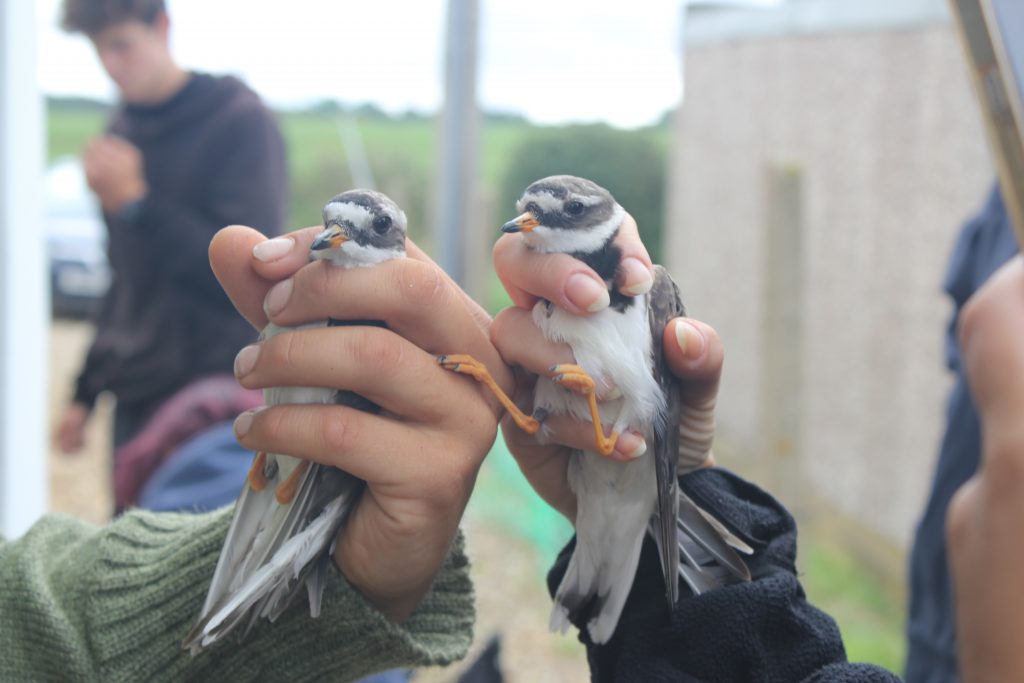
Heacham North North (Norfolk) 4 August 2023
| Species | New | Retrap | Total |
| Sanderling | 101 | 27 | 128 |
| Turnstone | 11 | 2 | 13 |
| Ringed Plover | 3 | 0 | 3 |
| Little Grebe | 1 | 0 | 1 |
| Totals | 115 | 29 | 145 |
Later, once warm and dry and eating our breakfast, Ryan led a team briefing and Richard went over the morning’s catch. Normally on our week-long trips we are split into two teams, one which covers Lincolnshire sites, and one which covers those in Norfolk. This year, as in the first Wash week last year, we began the trip by operating more or less as one big super team; however, at this point in the week, we divided off into our two teams. And so, the Lincolnshire team (with Kirsty, Ryan and Flo joining to give extra help) set off for a cabbage field near the old RAF control tower on the Lincs side, to set four full nets in two lines of two where Steve and Tim had seen birds roosting.
Steve and Tim directed the team setting these four nets and had already set the three-cannon net in the Horseshoe Lagoon – what busy bees! The Horseshoe net was set to hopefully catch Dunlin on Saturday morning, seen there by Steve, and the cabbage field nets were put in place for Sunday morning in the hopes of catching Curlew and Bar-tailed Godwit, of which 1,000 of each had been seen there by Tim! News of such large numbers of birds was very exciting. Their presence on the field was inarguable, thanks to the sheer amount of guano deposited on the soil! We were glad to have this field catch opportunity: at the beginning of the week it was looking unlikely we’d have one because unfavourable weather had meant most fields had not yet been harvested, minimising off-marsh roosting sites. In a neighbouring field, several hundred Golden Plover were seen, and a stunning Short-eared Owl was sighted quartering low over the salt marshes on its long wings.
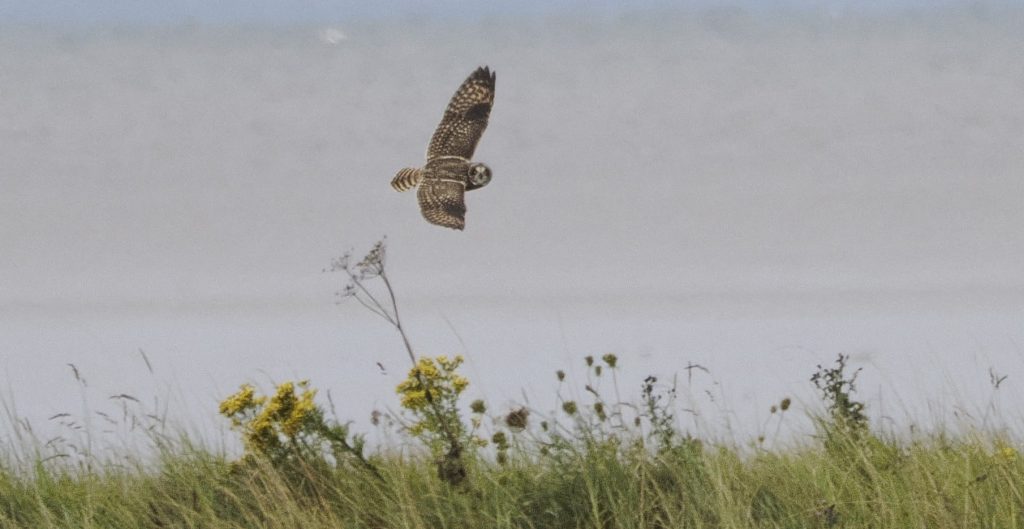
Sarah and Bob had made a scrummy curry and delicious apple strudel for the hard-working team when they returned to Friskney Village Hall. Shannon, Ed and Guy arrived that evening, and Steve talked with us all about plans for the morning catch. Everyone was feeling pleasantly sleepy and Flo strummed on the WWRG guitar (a recent addition to the group’s essential equipment – thank you Guy!) as they all settled into their sleeping bags.
The Norfolk side spent the afternoon sorting out equipment at the base and plans were made after supper (many thanks to Christine and Lys for the lovely curry followed by pie and fruit!) to head round to Lincolnshire in the morning to be ready in place behind the seawall for the expected Dunlin catch at the Horseshoe. Katharine and Jen arrived back from headstarting (the others had left a little earlier) and alongside Nigel, Katharine helped get the WWRG Curlew tags ready for deployment for the Sunday catch of Curlew before going to bed.
Saturday 5 August
The Lincolnshire team all got into place early before the Norfolk team arrived – both the hide and net-lifting teams were in vehicles due to the slightly damp weather and were in position by 07:30. Near continuous drizzle misted down on us throughout the morning. Two Avocets catchable early on sent Steve (who was leading the hide) into a frenzy of excitement. It was hard to know if he was joking or not! The radio chatter was positive with around 250 Dunlin coming into the right place on the Horseshoe (alongside 60–70 Oystercatchers) and though initially not moving into the right place they went into feeding mode and moved around more. Soon afterwards, once some birds had removed themselves from near the net, the hide team fired (though not many heard!) and everyone was up and out of their cars running for the net! Due to the water levels a stretcher of hessian was laid out behind and held up so that the birds in the net were being extracted from on top of this and kept dry. Once again, extraction was slick and efficient.
Steve had got permission from the landowner to make use of the former RAF building at the side of the Horseshoe which meant that we had a perfect set up for the damp conditions. The ringing team worked below the building and the processing team set themselves up upstairs (shoes off for the carpets!). Given the numbers of birds the team decided this was a perfect training opportunity and so a dummy processing team was set up to learn how to measure and age the Dunlin coming through. Everyone who wanted to get involved in this was able to and soon they were comparing techniques between themselves and the main processing team with Steve’s (and many others) help. It was also a very good opportunity to look at the differences between the two races of Dunlin we were seeing: Alpina and Schinzii. Cathy and Richard joined the team after some very successful Redshank and Oystercatcher resighting.
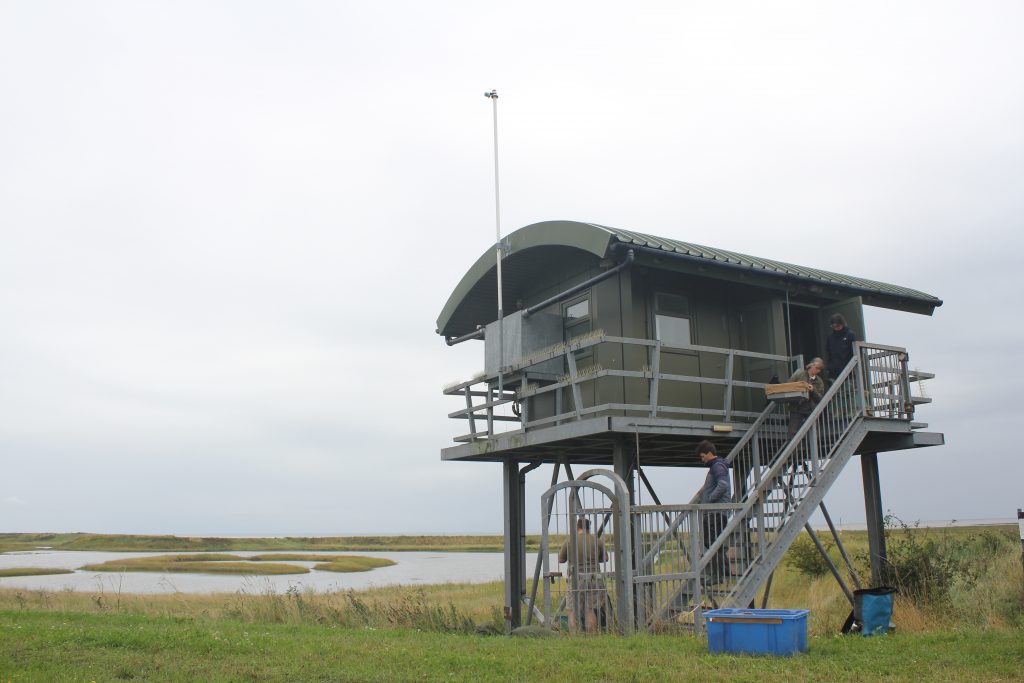
Horseshoe (Lincs) 5 August 2023
| Species | New | Retrap | Total |
| Dunlin | 110 | 3 | 113 |
| Oystercatcher | 2 | 0 | 2 |
| Total | 112 | 3 | 115 |
After all the birds were away and we’d cleaned up, everyone headed to the village hall for an excellent, well-deserved breakfast. Following a team chat about the morning, and given the cannon nets were all set for a Sunday morning catch, a plan was made for the Lincolnshire side to have a mist-netting session that evening on Friskney saltmarsh. Just before the teams were sorted out, Flo said goodbye to all as she had to head home early this trip. The Norfolk side headed back to resight and rest before coming back for the morning’s catch.
Part of the Lincolnshire team left Friskney Village Hall to set the mist nets at 19:00 and then came back to enjoy a bulked-up curry dinner before going out again.
The mist-netting ended up being rather quiet with only 27 birds caught in total due to a combination of light persisting and it being a rather quiet night for movements of birds. The team went back to the village hall and fell fast asleep.
Friskney Pools (Lincs, mist-netting – 1 pool, 10 nets) 5 August 2023
| Species | New | Retrap | Total |
| Bar-tailed godwit | 7 | 0 | 7 |
| Dunlin | 12 | 1 | 13 |
| Knot | 2 | 0 | 2 |
| Redshank | 5 | 0 | 5 |
| Totals | 26 | 1 | 27 |
Sunday 6 August
The Lincolnshire team were up and out to the Curlew field set to put up two hides (one for each line of nets) with strict instructions given to all to not damage any cabbages in the process! With two hides, up to eight people could be in them, giving some people their first views of a net firing. The other team members (and the Norfolk team when they arrived) stayed further back at the corner of the next field ready for twinkling and running to the net when the catch was hopefully made.
The first birds (Curlew and Bar-tailed Godwit) came over the seawall an hour before high tide (“just like 20 years ago!” said a long-standing member) and with there being birds in the catching area from the start the firing box was soon armed; but the birds didn’t stay. A Peregrine sent many birds scattering both north and south and so twinklers were sent off (via cars along the seawalls) to try to find them and hopefully persuade them to return – many thanks to Richard, Christine, Cathy and the whole Bone family for this work, with 300 birds finally settling back across the field. The near end of Steve’s net got some birds coming in and, with some additional car twinkling by Ryan, the birds were moved to just a short distance from the net… And so, with numbers getting higher, Steve took a catch sooner rather than later – better some than no birds at all!
This worked and soon the team were working (quietly, given there were Curlew) to process the 28 birds caught and take four of them to the flagging (Jacquie and Nat) and tagging teams (Nigel, Lizzie and Katharine). Four of the birds, two males and two females, were selected for tagging and were fitted with GPS tags. They will add to our knowledge of how birds use The Wash.
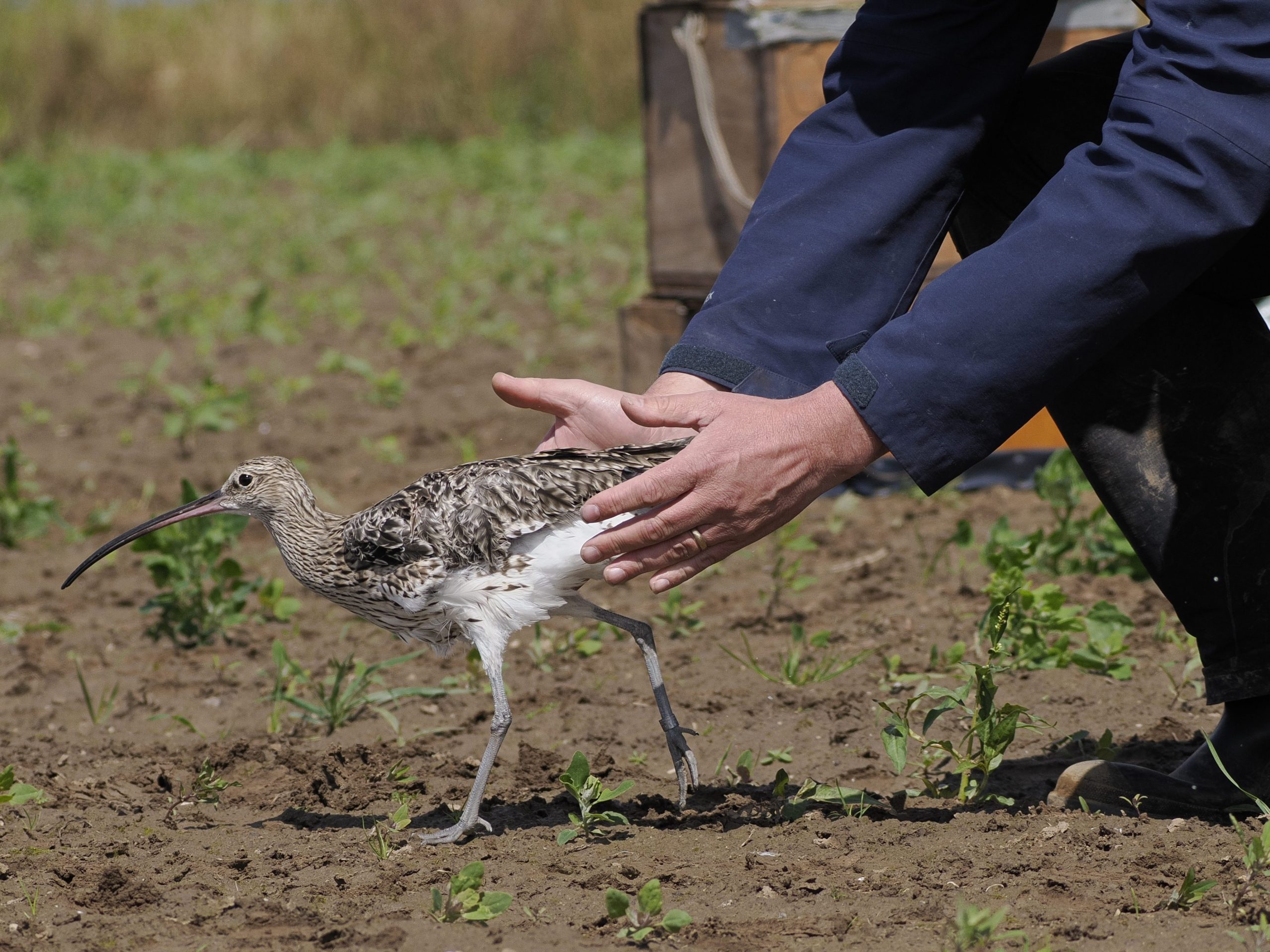
Cabbage field (Lincs) 6 August 2023
| Species | New | Retrap | Total |
| Curlew | 26 | 2 | 28 |
| Total | 26 | 2 | 28 |
With the cannon-netting opportunities finished for the week, the teams went back to the village hall for breakfast and the final plans were made for two mist-net catches – one on the Lincs side (Leverton – Bowser) and one in Norfolk (Terrington Marshes) with the majority of people in Norfolk. Some good kit sorting then happened before the Norfolk team left and Katharine and Ursula set off to shop for dinner for the Lincs team. The Lincs team took the opportunity to catch some sleep, having been out the previous night, and then headed out to set the nets. Katharine and Ursula prepared a huge pasta bake (Italian style with cream and mozzarella layered in it) which they brought out to the setting team for 21:00 before the first net rounds. The catch was again small though better than the previous night. The wind had picked up and the nets were visible, but the team worked well to get birds off the marsh and the nets down again with several people getting mist-net extraction practice. The team was back and into bed by 02:00.
Leverton Saltmarsh (Lincs, mist-netting – 9 nets) 6 August 2023
| Species | New | Retrap | Total |
| Dunlin | 33 | 0 | 33 |
| Redshank | 7 | 0 | 7 |
| Turnstone | 1 | 0 | 1 |
| Totals | 41 | 0 | 41 |
It was a great and very busy night at Terrington, with 185 birds caught over the pools and the team were just heading to bed as the sun was rising – a very long (but successful) day had by them all!
Terrington Saltmarsh (Norfolk, mist-netting – 15 nets) 6 August 2023
| Species | New | Retrap | Total |
| Bar-tailed godwit | 1 | 1 | 2 |
| Black-tailed godwit | 6 | 0 | 6 |
| Curlew | 1 | 0 | 1 |
| Dunlin | 97 | 2 | 99 |
| Grey Plover | 9 | 0 | 9 |
| Redshank | 49 | 3 | 52 |
| Ruff | 3 | 0 | 3 |
| Shelduck | 1 | 0 | 1 |
| Turnstone | 7 | 0 | 7 |
| Whimbrel | 5 | 0 | 5 |
| Totals | 179 | 6 | 185 |
Monday 7 August
The Lincolnshire team woke up slowly and though a few team members sadly had to be away early to catch trains or start long journeys, the rest were able to stay awake a little longer to make sure the village hall was clean and additional food and kit packed up to head round to the Norfolk base. Goodbyes were said and soon the final members had locked up and were in Norfolk unloading and helping pack away kit and gear with the remaining Norfolk team.
Trip Ringing Totals 2–7 August 2023
| Species | New | Retrap | Total |
| Bar-tailed godwit | 8 | 1 | 9 |
| Black-tailed godwit | 6 | 0 | 6 |
| Curlew | 27 | 2 | 30 |
| Dunlin | 252 | 6 | 258 |
| Grey Plover | 9 | 0 | 9 |
| Knot | 2 | 0 | 2 |
| Oystercatcher | 203 | 21 | 224 |
| Redshank | 61 | 3 | 64 |
| Ringed Plover | 3 | 0 | 3 |
| Ruff | 3 | 0 | 3 |
| Sanderling | 101 | 27 | 128 |
| Turnstone | 19 | 2 | 21 |
| Whimbrel | 5 | 0 | 5 |
| Little Grebe | 1 | 0 | 1 |
| Shelduck | 1 | 0 | 1 |
| Totals | 701 | 62 | 763 |
Resightings August 2–7 August 2023
| Species | Sightings | Individuals |
| Bar-tailed Godwit | 46 | 44 |
| Curlew | 61 | 43 |
| Redshank | 25 | 16 |
| Turnstone | 7 | 5 |
| Knot | 51 | 47 |
| Black-tailed Godwit | 52 | 43 |
| Oystercatcher | 8 | 7 |
| Totals | 250 | 205 |
Resighting notes (thanks to Carole Davis and Bernard Siddle):
Black-tailed Godwit resightings were almost all from the large roosting groups on Snettisham Pits. They included birds from at least nine different colour-marking schemes in the UK, Iceland, France, Portugal and The Netherlands.
WWRG Bar-tailed Godwit resightings included some birds that had been ringed several years ago which have only been seen a couple of times on The Wash since (and only in August/September). These are likely to be birds that are only present here on passage. They included two birds, resighted together on Snettisham mudflats, that had been ringed together in August 2018 and not seen since December 2018.
Good numbers of WWRG Redshank and Curlew were resighted, from Freiston and Snettisham respectively. Non-WWRG Curlew included four headstarted birds (two from the 2022 cohort and two from this year) which were feeding out on the mud from Snettisham north beach, intermingled with the other Curlews.
There were seven Oystercatchers resighted, all but one at Freiston Shore. Four were from the same colour marking scheme in Rogaland Norway, one from Lofoten Norway and two from the Netherlands.
Knot resightings were all from one small island in Snettisham Pits, which, according to the WeBS counter, held 20,000 birds. Resightings were of birds ringed in Iceland (11), Norway (1), the Netherlands (8), NW England and Wales (13), The Wash (5) and Scotland (4).
Thank you to everyone involved in this first Wash Week of the year. It was a fantastic trip with several very successful catches, great training opportunities for everyone on the team and brilliant teamwork shown at every stage. As always, so many people worked really hard to collect resighting data – such worthwhile dedication, contributing to the group’s research. It was wonderful to have so many new and enthusiastic members joining the trip, and equally lovely to see some old faces return to The Wash after a long time. Looking forward to the next Wash Week!
Thanks to Florence Turner and Katharine Bowgen for writing this report. Cover photo by Nigel Clark.

